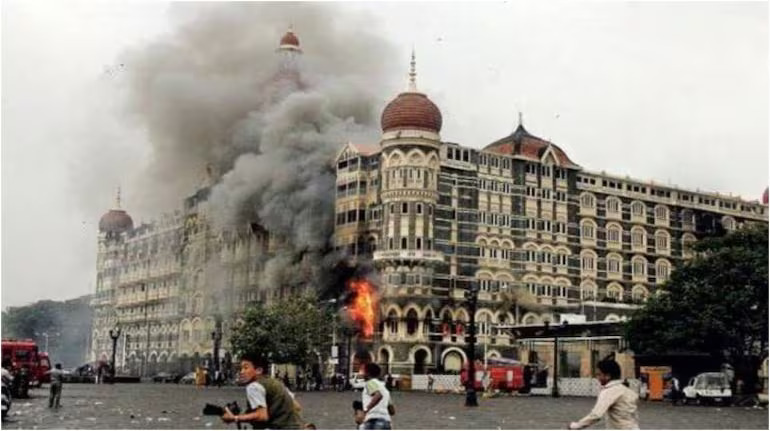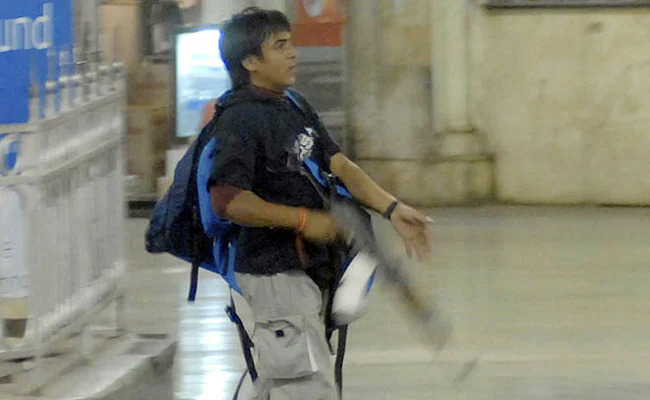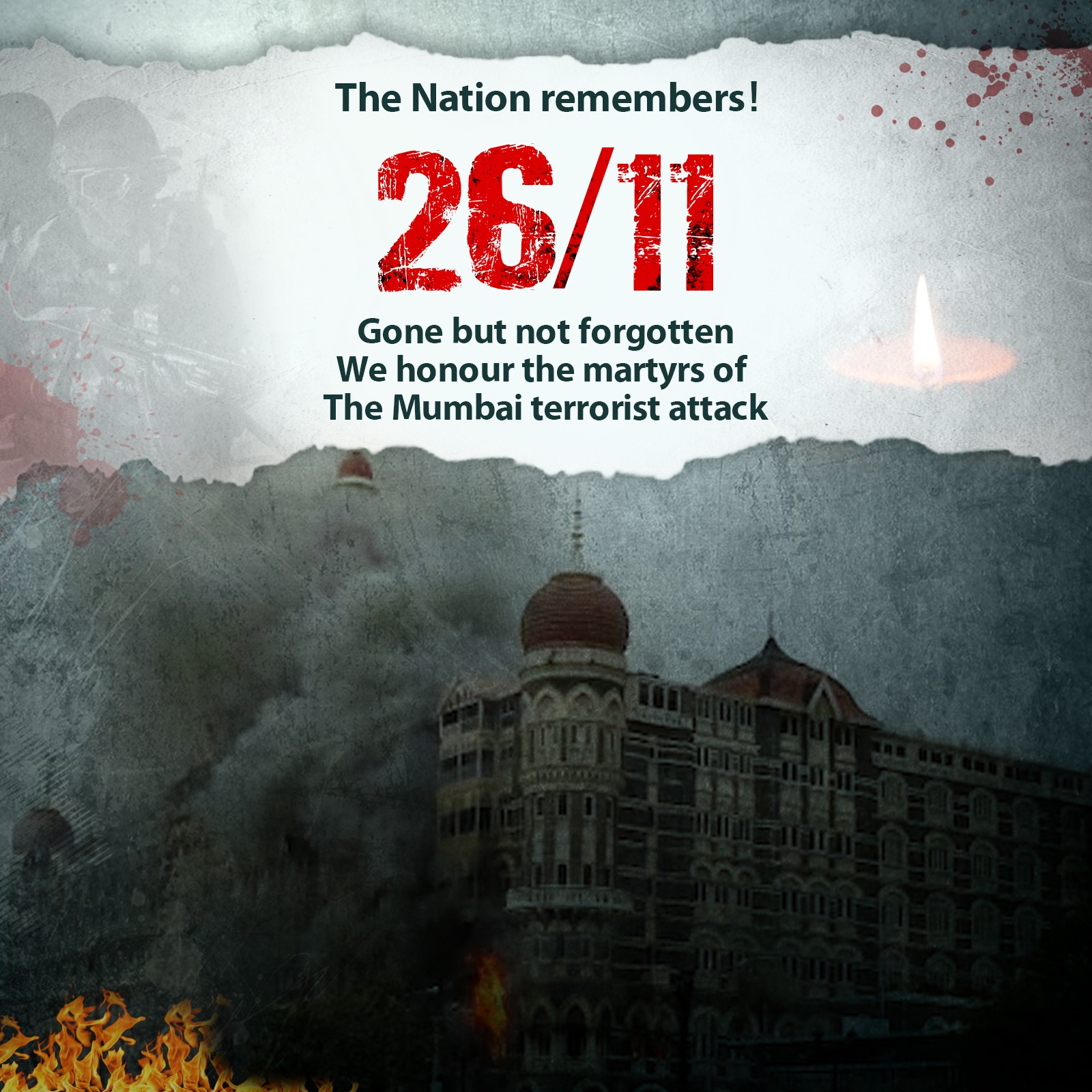Back on November 26, 2008, a group of 10 terrorists from Pakistan sneaked into south Mumbai by sea. They carried out attacks in various parts of the city. This assault, orchestrated by the Pakistani terrorist organization Lashkar-e-Taiba, resulted in the tragic loss of 166 lives and left more than 300 people injured.
26/11 Mumbai Terror Attacks

Today, Maharashtra Governor Ramesh Bais and Chief Minister Eknath Shinde paid tribute to the heroes who sacrificed their lives during the Mumbai terror attacks 15 years ago. The three-day-long tragedy is widely remembered as the 26/11 Mumbai terror attack.
Bais and Shinde laid flowers in memory of the martyrs at the memorial situated in the Police Commissioner Office grounds in South Mumbai. Alongside them, senior police officers and the families of the brave policemen also came together to honour and remember the fallen heroes.
On the fateful day of November 26, 2008, a group of ten terrorists from Pakistan infiltrated the southern coastal areas of Mumbai, arriving by sea. Their nefarious mission involved launching coordinated attacks at various locations across the city. The perpetrators, affiliated with the Pakistani terrorist organization Lashkar-e-Taiba (LeT), executed a ruthless assault that resulted in the tragic loss of 166 lives, while also inflicting injuries on more than 300 individuals.
As the anniversary of this grim event approached last week, Israel took the opportunity to reaffirm its classification of LeT as a terrorist organization. Israeli Foreign Ministry spokesperson Lior Haiat, in a statement to PTI, explained that this designation, initially put in place in 2013, was recently reasserted in official records.
It’s poignant to note that among those who fell victim to the terror attack, six individuals from the Jewish community lost their lives during the hostage situation at Chabad House (Nariman House). This remembrance also occurs within the broader context of Israel’s ongoing conflict with Hamas, adding a layer of complexity and significance to the commemorations.
Also Read: Caller warns Mumbai Police of 26/11-like terror attack again if…
Timeline of the 2008 Mumbai Terror Attacks
A series of coordinated bombings and shootings, orchestrated by 10 terrorists, unfolded tragically in Mumbai, claiming the lives of 166 individuals. Here’s a closer look at the timeline of these harrowing events:
On the evening of November 21st: Ten terrorists set out from Karachi, Pakistan, embarking on a journey aboard a boat that spanned approximately thirty-eight hours, successfully evading detection by the Indian Navy.
November 22nd: Each of the ten men is equipped with six to seven magazines, each containing 30 rounds, along with an additional 400 rounds not loaded in magazines. They carry 8 hand grenades, an AK-47 assault rifle, an automatic loading revolver, credit cards, and a supply of dried fruit.
November 23rd: The terrorists hijack an Indian trawler named the Kuber, leading to the tragic death of four fishermen. They coerce the captain into sailing towards India.
On the 26th of November: Coming within four nautical miles (7 kilometers) of Mumbai, the terrorists take the life of the captain of the Kuber. Subsequently, they board three inflatable speedboats, making their way towards Colaba jetty.
By 08:10 pm, the boat docks at Macchimar Nagar in Mumbai’s Cuffe Parade neighborhood. Six terrorists disembark here, while the remaining continue sailing along the shore. When questioned about their occupation by local residents, they claim to be students.
At 08:30 pm, another group disembarks at Badhwar Park in Colaba, Cuffe Parade. Confronted by Marathi-speaking fishermen, they instruct them to mind their business before dispersing in different directions.
Gunshots are reported at Leopold Cafe, resulting in the tragic loss of 10 lives and injuring many, including a Reuters news reporter. Bombs are also planted in two taxis, causing the death of five individuals and injuring 15.
CSK Squad Shake-up: Full Roster Moves in IPL 2024 Auction – Retained and Released Players Revealed!
Four assailants enter the Taj Mahal Hotel, two infiltrate the Oberoi Trident, two make their way into Nariman House, and two others, Ajmal Kasab and Ismail, take a taxi to Chhatrapati Shivaji Maharaj Terminus (CSMT).
At 09:20 pm, armed with AK-47 and AK74U rifles, Kasab and Ismail initiate an assault at CSMT, leading to the heart-wrenching loss of 58 lives and injuring 104 through gunfire and grenade attacks.
By 10:30 pm, Kasab and Ismail head to Cama Hospital. Hospital staff lock patients’ rooms upon noticing their approach. ATS chief Hemant Karkare and three officers lose their lives in a confrontation. The terrorists hijack a jeep but are intercepted near Girgaum Chowpatty by the Gamdevi police. Ismail is killed, and Kasab is arrested.
On the 28th of November: Commando operations at the Oberoi Hotel conclude, with 24 bodies recovered and 143 hostages rescued alive. Two terrorists are neutralized.
At 07:30 am, NSG commandos are deployed via fast-rope onto the roof of Nariman House, with snipers stationed in nearby buildings to prevent attacks on the commandos.
By 07:30 pm, the commandos discover all six hostages, including the rabbi and his wife, tortured and murdered by the terrorists.
At 08:30 pm, commandos engage in a fierce gunfight, eliminating the two terrorists and declaring the Nariman House operation concluded.
On the 29th of November: At 08:00 am, commandos announce control over the Taj Hotel, despite ongoing room-to-room searches. Celebration erupts on the streets.
By 04:20 pm, the Taj Mahal Hotel is reported to be completely under government control.
Remembering Gruesome Mumbai Terror Attacks
The nine Lashkar-e-Taiba (LeT) terrorists met their end, and Mohammad Ajmal Amir Qasab, the lone surviving Pakistani terrorist involved in the attack at the Chhatrapati Shivaji Terminus railway station, was apprehended. In May 2010, Qasab received the death penalty, and two years later, he was executed in a maximum-security prison in Pune city.

The wounds left by this tragic event persist in the collective memory of those who lived through it, and the insights gained from that dark day remain pivotal for global security.
On the 15th anniversary of these sorrowful terror attacks, Israel has officially labeled Lashkar-e-Taiba (LeT) as a terrorist organization. Notably, this action was taken without any formal request from the Indian government.
The Israeli Embassy explained in a statement that all necessary procedures have been completed to declare LeT a terrorist outfit. They emphasized that this decision was made independently, without a specific request from the Indian government. Israel’s Minister of Defence and Minister of Foreign Affairs collaborated in recent months to fast-track the extraordinary listing of Lashkar-e-Taiba on this date, underscoring the importance of a united global front against terrorism.
Israel’s Ambassador to India, Naor Gilon, applauded the decision, describing the ban on Lashkar-e-Taiba as the “right thing.” He noted that Israel had decided to ban LeT a few months ago after discovering that it wasn’t listed as a terrorist organization in Israel.
Simultaneously, a day-long poster exhibition was held at the Broken Chair in front of the United Nations in Geneva to commemorate the 26/11 Mumbai terror attacks. Priyajit Debsarkar, a human rights activist and author who organized the exhibition, expressed, “Today, we are protesting in front of the United Nations, Geneva. We have displayed a lot of balance here to commemorate the costly and terrible barbaric terror attacks that shook Mumbai, the Indian financial epicentre, 15 years ago.”
Sachin Tendulkar tweet remembering 26/11

